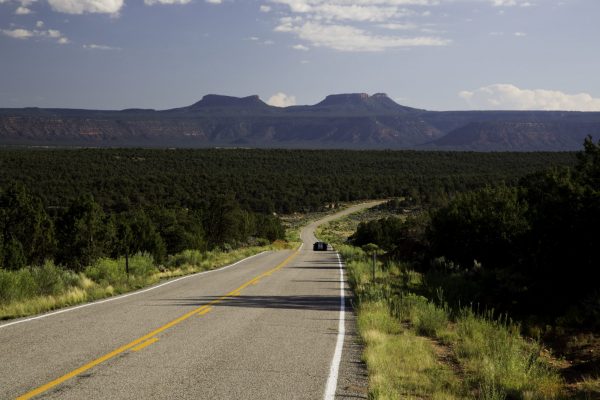Introduction
In southern Utah, two bear’s ears poke out from the face of the earth.
Shash Jáa,[1] as the Navajos call the buttes, graces the horizon from all directions. Beneath their splendor lie cliff dwellings, rock art, and ceremonial sites, the material vestiges of many stories.[2]
It is, as the five-tribe Bears Ears Inter-tribal Council said, one of the precious few places on earth where “the ancient past makes itself undeniably present.”[3]

There is no better place to from which to launch a conversation about public lands history than Shash Jáa, or as the Hopi call it, Hoon’Naqvut.[4]
On December 28, 2016, President Barack Obama designated Bears Ears National Monument in San Juan County, Utah. The monument’s establishment called for an innovative management partnership among two federal agencies and five Indian tribes, the Hopis, Zunis, Ute Mountain Utes, Uintah and Ouray Utes, and Diné (Navajos). Within months, President Donald Trump’s Interior Secretary Ryan Zinke put the monument under scrutiny for possible modification or elimination, igniting intense public conversation. In December of 2017, Trump stood on the steps of the Utah Capital building and announced his plan to shrink Bears Ears National Monument. Whatever the fate of this place the Utes call Kwiyagatu Nukavachi, the debate has raised questions about federalism, economic development, voices of local peoples, public lands law, ecological health, and the place of indigenous peoples in American society.
Bears Ears and its Many Pasts
Often lost in the shouting is history. Native American understandings of Bears Ears, or Ansh An Lashokdiwe as it is known to Zunis, exhibit a keen sense of their own past. This historical awareness is grounded in the monument’s more than 100,000 archaeological sites and associated tribal stories and traditions. A Ute Indian Tribe press release called Bears Ears a “sacred” place. “Our history and our future – our Ute identity,” the statement said, “is inextricably tied to this place.”[5]
Native American history also includes years of federal control over their lands and lives. White anthropologists, archaeologists, and historians have told them about their past, and white scientists have told them how to manage their land. In this light, the joint management partnership is historic. It breaks from 150 years of disempowerment and restores a small bit of autonomy over their lands and their pasts. It also gives tribes the chance to insist on the government-to-government relationship of equals they legally hold with the United States, but which the federal government often ignores in practice.[6] As Navajo Nation Council Delegate Davis Filfred noted, “The designation of Bears Ears National Monument was a celebratory moment where our voice was finally heard, and our cultural and spiritual heritage was respected.”[7]

More pasts: native peoples (like all other people) do not speak with one voice. Some doubt the wisdom of having a monument at Bears Ears. Critics caution that Indians have been ill-used by environmentalists in the past. Allying with some of those same people to protect the national monument now, they argue, is a recipe for repeating those misfortunes.[8]
And then there are white locals, who also legitimately claim the heritage of their ranching, farming, homesteading, and prospecting forebears who came to the region decades ago.
Many pasts indeed!
A Future for Bears Ears
Paying attention to history suggests that the national monument can be a vehicle through which we can honor many pasts. The existence of the Inter-tribal Council, which has drawn together Diné, Ute, Hopi, and Zuni tribes (among other groups at various times) to advocate for the monument, suggests that it can preserve multiple heritages—Shash Jáa, Hoon’Naqvut, Kwiyagatu Nukavachi, Ansh An Lashokdiwe, Bears Ears. And as the Ute Indian Tribe press release noted, recognizing this place can “help visitors understand and respect our history so that we may all continue to use and enjoy these lands together.”[9]
Out of a public conversation that features many pasts can grow a Bears Ears that can do many things. Those stubby buttes that rise above the desert can nurture cultural continuity of tribal pasts and presents. They can also inspire non-native visitors to learn to respect that heritage. The monument can be a place for all people to sense and appreciate the deep continuum of human life –ancient and recent—that abides there. It can start a break from a century of marginalization and enable historically unheard peoples to be listened to. Shash Jáa can be a place to begin to right historical wrongs.
That opportunity should not be lost on land managers and the courts as they decide how to preserve Bears Ears.
– Dr. Jared Orsi, PLHC Director and Faculty Council Chair
Sources
[1] Twenty-Third Navajo Nation Council Office of the Speaker, “Navajo Nation Calls on President Obama to Protect Bears Ears,” May 19, 2016, http://www.bearsearscoalition.org/wp-content/uploads/2016/05/FOR-IMMEDIATE-RELEASE-Navajo-Nation-calls-on-President-Obama-to-protect-Bears-Ears.pdf.
[2] “Tribes Uniting to Protect Bears Ears,” http://bearsearscoalition.org/about-the-coalition/tribal-statements-of-support/.
[3] “Bears Ears: A Native Perspective on America’s Most Significant Unprotected Area,” http://www.bearsearscoalition.org/wp-content/uploads/2016/03/Bears-Ears-bro.sm_.pdf.
[4] The area around the buttes goes by many names; https://shashjaa.wordpress.com/2018/01/05/whats-in-a-name-bears-ears-and-our-many-names-to-this-place/. For the sake of intertribal unity, the tribes whose languages each name it differently, have used the English term “Bears Ears.” To honor native place names while not privileging any one of them over the others, we have chosen in this essay to use five native names plus English.
[5] “Ute Indian Tribe Praises Protection of Bears Ears Sacred Landscape,” Ft. Duchesne, UT, December 28, 2016, http://bearsearscoalition.org/wp-content/uploads/2017/01/Bears-Ears-PR-Final-12-28-16.pdf.
[6] “Tribes Uniting to Protect Bears Ears,” http://bearsearscoalition.org/about-the-coalition/tribal-statements-of-support/.
[7] “Tribal Leaders Outraged over Executive Order to Undermine Bears Ears,” http://bearsearscoalition.org/tribal-leaders-outraged-over-executive-order-to-undermine-bears-ears-national-monument/.
[8] Kim Baca, “Bears in Crosshairs as Zinke Tours,” Indian Country Today, May 12, 2017, https://indiancountrymedianetwork.com/news/politics/bears-ears-crosshairs-zinke/.
[9] “Ute Indian Tribe Praises Protection of Bears Ears Sacred Landscapte,” Ft. Duchesne, UT, December 28, 2016, http://bearsearscoalition.org/wp-content/uploads/2017/01/Bears-Ears-PR-Final-12-28-16.pdf.